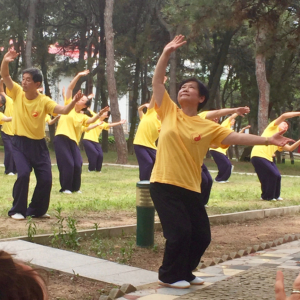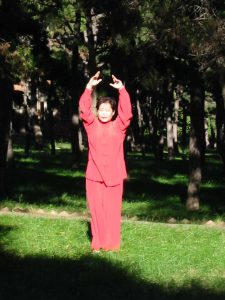
History of Nei Yang Gong Qigong
Nei Yang Gong Qigong (Inner Nourishing Qigong) dates back to the Qing Dynasty beginning with Master Hao Xiang Wu. It was first introduced as “medical qigong” by Dr. Liu Gui Zhen. Dr. Liu Gui Zhen became known as the “father” of “modern medical qigong” and he reintroduced the term “qigong” into the practice of Chinese medicine in modern China.
Dr. Liu Gui Zhen founded Tangshan Qigong Sanitarium in the late 1940’s after he had suffered a long illness and cured himself with the practice of Nei Yang Gong qigong. His clinic in Tangshan was the first Chinese medicine clinic to use qigong (Nei Yang Gong) as a therapeutic practice. He was recognized and awarded for this in 1955 when The Chinese Medicine Academy was founded in Beijing China by Chairman Mao. At this time the hospital was relocated to Beidaihe, China, and it became a national training base for medical qigong, specifically Nei Yang Gong.
In the 1960’s, the Cultural Revolution closed the hospital. Dr. Liu Gui Zhen and his daughter, Dr. Liu Yafei, were sent to a re-education camp in Shang Hai Guan. In the 1970’s, after the Cultural Revolution, the hospital re-opened in Beidaihe. Many foreigners, including doctors from Harvard University, David Eisenberg (Encounters with Qi, 1995), came to the hospital to study the clinical practice of “medical qigong”. For more information read the following article by John Voigt in Qi – The Journel of Traditional Eastern Health & Fitness, Dr. Liu Gui Zhen: The Man Who Invented Qigong
Dr. Liu Yafei
Dr. Liu Yafei, the daughter of Dr. Liu Gui Zhen, studied Chinese medicine at Tian Jin University in China. She inherited her father’s practice of Nei Yang Gong when he passed away in 1983. Dr. Liu Yafei choreographed a set of 24 movements (Dong Gong or Dynamic qigong). They are published in German by Elsevier Publishing: Innen Nährendes Qigong or Inner-Nourishing Qigong. The book provides insights of modern medicine on the physiological effects of qigong as well as a detailed description of the principle and the effect of Nei Yang Gong on all major organ systems.

Dr. Liu Yafei is an international lecturer in Japan, Germany, France, Austria, Sweden, Switzerland, and Ireland. She teaches courses at the University of Bremen and at the University of Oldenburg in Germany. She also lectures with the German Qigong Association, the Medical Society of Qigong Yangsheng, the Association for Classical Acupuncture and Traditional Chinese Medicine, and the Sports University in Cologne Germany.
Dr. Liu Yafei was the director of Beidaihe Sanitarium, Beidaihe, China and is now retired. She has participated in qigong research and is in national publications in China. In 2005 The National Medical Qigong Training Base at Beidaihe became the “sister” affiliate of The Shanghai Qigong Institute with Shanghai University of Traditional Chinese Medicine.
Nei Yang Gong Practice
Nei Yang Gong Qigong has a quiescent (quiet) practice and a movement practice. The quiescent practice has a series of breathing exercises to help the practitioner learn to guide qi in the body. This technique helps to unblock stagnated qi. The movement practice of Nei Yang Gong Qigong consists of 24 forms. The first set 12 forms are called Muscle Strengthening and Qi Regulating. The second set of 12 forms are called Longevity and Qi Regulating. The first 6 forms in each set employs the Yin breathing pattern: Inhale, Exhale, Pause, which is primarily used for Yin Deficiency conditions. The second 6 forms in each set employs the Yang breathing patten: Inhale, Pause, Exhale, which is primarily used for Yang Deficiency conditions. The forms can be practiced as a set or used individually depending on the practitioner’s condition.
The International Qigong Foundation, Inc. offers classes in Nei Yang Gong Qigong. We also offer specialized training courses to healthcare providers. All of our instructors are trained and certified with Dr. Liu Yafei at the The National Medical Qigong Training Base in Beidaihe, China.

